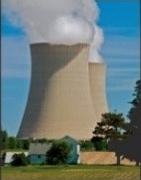Statement on the 39th Anniversary of the Chernobyl Nuclear Disaster
On April 26, 2025, we mark 39 years since the largest man-made disaster of the 20th century — the accident at the Chernobyl Nuclear Power Plant. This tragedy cast a dark shadow over Ukraine, Lithuania, Poland, and many other European countries.
Belarus became the country with the most contaminated territory (23%) and, as a result, the gravest long-term consequences. For our country, Chernobyl is not just a technological disaster — it is a national wound: poisoned land, water, and air; the nation’s compromised health; sick children — all of this has become part of Belarusian reality. This catastrophe will remain with us for hundreds of thousands of years — until all toxic radionuclides decay.
On this dark day, Belarusians around the world hold mourning marches known as the “Chernobyl Way” to honor the memory of the disaster’s victims. For many years, civil society in Minsk carried this event forward, defying the constraints of a totalitarian regime.
The totalitarian USSR enabled the conditions that made the Chernobyl catastrophe possible. The dictatorship of Lukashenka continues to exacerbate its consequences by:
· silencing facts and downplaying risks,
· putting contaminated land back into economic use,
· depriving Chernobyl victims and affected people of social benefits,
· repressing scientists, activists, and organizations speaking the truth about Chernobyl, many of whom have been imprisoned or are currently behind bars,
· promoting dangerous Russian nuclear technologies in Belarus, at the doorstep of neighboring countries: both nuclear weapons and the Astravets NPP, which had been erected with violations of European safety standards and national legislation, in a non-transparent and undemocratic way,
· discussing the construction of a second NPP while the first is underutilized for half of its operational time and the energy system has no need for its electricity.
Nuclear disasters do not occur only in authoritarian countries — democracies are not immune either. We learned this from the example of Fukushima. Moreover, even democratic nations can exhibit authoritarian tendencies, as we have seen in the past decade.
Democratic countries with nuclear plants may become targets of nuclear terrorism and military aggression, as demonstrated by Russia’s attacks on Ukraine and on Chernobyl and Zaporizhzhya NPP in 2022 and 2025.
At the same time, the international democratic community and the IAEA have proven incapable of effectively addressing the problems of nuclear blackmail, military attacks on nuclear facilities, or dealing with the consequences of nuclear disasters.
Sadly, the lessons of Chernobyl remain unlearned. Countries are not abandoning nuclear energy — instead, they present it as climate-friendly and conditionally “green,” using calculations that ignore technological realities and associated risks, as well as the full nuclear fuel cycle. The issue of spent nuclear fuel, which remains toxic for up to a million years (according to the IAEA), remains unresolved.
The world’s fleet of operating nuclear power plants is aging. Yet instead of transitioning to cheaper, more accessible energy generation technologies — including renewables — many countries are extending the life of existing plants and attempting to restart shut-down reactors, creating significant safety risks.
Nuclear materials continue to spread globally, and the threat of nuclear conflict is growing.
On this day, we address the authorities of Belarus with the following demands:
· Immediately shut down and decommission the Astravets NPP, which is unsafe and unnecessary.
· Return Belarus to its nuclear-free and neutral status.
· Remove Chernobyl-contaminated areas from economic use.
· Restore social support for people affected by the consequences of the Chernobyl disaster.
· Resume scientific research on the consequences of the Chernobyl accident and reestablish cooperation with the global scientific community for this purpose.
· Release environmental activists and all other political prisoners, including participants in the anti-nuclear movement.
· Support Belarus’ transition to a sustainable energy system based primarily on renewable and decentralized sources.
We call on the international community to:
· Consider the deployment of nuclear weapons in Belarus as a violation of the principles of collective security.
· Strip nuclear energy from green agendas (such as ESG frameworks and climate finance mechanisms).
· Prioritize conventional deterrence means and strategies over nuclear weapons.
· Ban the trade of uranium and nuclear technologies with aggressor states (such as the Russian Federation).
· Prevent the militarization of nuclear facilities by strengthening international legal frameworks and undertaking coordinated action within the global community.
· Honor the memory of the victims of the Chernobyl disaster and continue supporting liquidators and those affected.
· Express solidarity with the people of Ukraine, who faced nuclear threats during acts of military aggression.
We also appeal to the member states of the IAEA with a proposal to reconsider the organization’s core priorities and put human safety above profits and the ambitions of individual states. We call on the IAEA to take the risks associated with nuclear technology use and proliferation seriously. To that end, we urge the IAEA to revise its guarantees, protocols, and mechanisms in such a way that the organization, which is promoting a so-called “nuclear renaissance,” bears legal and financial responsibility for the consequences of nuclear accidents and nuclear terrorism.
The resolution was adopted by NGO Ecohome, Green Network, Belarusian National Platform of the Eastern Partnership Civil Society Forum, Dapamoga, Solidarity Movement “Together,” Narodnaya Hramada, the United Civic Party, Our House, and the RE:Belarus Association of Belarusian Political Prisoners, Association of Belarusian Political Prisoners “Da Voli,” and supported by the United Transitional Cabinet of Belarus, the Office of Sviatlana Tsikhanouskaya.
チェルノブイリ原子力発電所事故39周年に関する声明
2025年4月26日、私たちは20世紀最大の人為的災害—チェルノブイリ原子力発電所事故—から39年を迎えます。この悲劇はウクライナ、リトアニア、ポーランド、そして多くの他のヨーロッパ諸国に暗い影を落としました。
ベラルーシは最も汚染された領土(23%)を持つ国となり、その結果、最も深刻な長期的影響を受けることになりました。私たちの国にとって、チェルノブイリは単なる技術的災害ではなく—国民の傷:汚染された土地、水、空気;国民の健康被害;病気の子どもたち—これらすべてがベラルーシの現実の一部となりました。この大惨事は、すべての有毒な放射性核種が崩壊するまで、何十万年もの間私たちと共にあり続けるでしょう。
この暗い日に、世界中のベラルーシ人は「チェルノブイリの道」として知られる追悼行進を行い、災害の犠牲者の記憶を称えます。長年にわたり、ミンスクの市民社会は全体主義体制の制約に立ち向かいながら、この行事を前進させてきました。
全体主義的なソビエト連邦は、チェルノブイリの大惨事を可能にした条件を作り出しました。ルカシェンコの独裁政権は、以下のようにその結果をさらに悪化させ続けています:
• 事実を闇に葬り、リスクを過小評価する
• 汚染された土地を経済利用に戻す
•チェルノブイリの被害者や影響を受けた人々から社会的恩恵を奪う
•チェルノブイリについて真実を語る科学者、活動家、組織を弾圧し、その多くが投獄され、現在も刑務所にいる
• 隣国の玄関口で危険なロシアの核技術をベラルーシで推進:核兵器とアストラヴェツ原発の両方を、欧州の安全基準や国内法に違反して、非透明かつ非民主的な方法で建設
•一号機が運転時間の半分も稼働しておらず、エネルギーシステムがその電力を必要としていないにもかかわらず、二号機の建設について議論している。
核災害は権威主義国だけで起こるわけではありません—民主主義国も免れないことを福島の例から学びました。さらに、民主主義国でさえ、過去10年間に見られたように、権威主義的傾向を示すことがあります。
原子力発電所を持つ民主主義国は、2022年と2025年のロシアによるウクライナやチェルノブイリ、ザポリージャ原発への攻撃が示すように、核テロや軍事的侵略の標的になる可能性があります。
同時に、国際民主主義コミュニティとIAEAは、核による脅迫、核施設への軍事攻撃、または核災害の結果に効果的に対処する能力がないことが証明されています。
残念ながら、チェルノブイリの教訓は学ばれていません。各国は原子力発電を放棄するどころか、技術的現実や関連リスク、さらには核燃料サイクル全体を無視した計算を用いて、気候に優しく条件付きで「グリーン」であるとして提示しています。IAEAによれば最大100万年間有毒であり続ける使用済み核燃料の問題は未解決のままです。
世界の稼働中の原子力発電所は老朽化しています。しかし、より安価で、より利用しやすいエネルギー生産技術—再生可能エネルギーを含む—への移行の代わりに、多くの国々は既存の発電所の寿命を延長し、閉鎖された原子炉を再稼働させようとして、重大な安全リスクを生み出しています。
核物質は世界中に広がり続け、核紛争の脅威が高まっています。
この日、私たちはベラルーシ当局に以下の要求を提出します:
• 安全でなく、不必要なアストラヴェツ原発を直ちに停止し、廃炉にすること。
•ベラルーシを非核・中立の地位に戻すこと。
•チェルノブイリ汚染地域を経済利用から除外すること。
•チェルノブイリ災害の影響を受けた人々への社会的支援を回復すること。
• チェルノブイリ事故の影響に関する科学的研究を再開し、この目的のためにグローバルな科学コミュニティとの協力を再確立すること。
• 環境活動家および反原発運動の参加者を含むすべての政治囚を解放すること。
• 主に再生可能で分散型のエネルギー源に基づく持続可能なエネルギーシステムへのベラルーシの移行を支援すること。
私たちは国際社会に以下を呼びかけます:
• ベラルーシにおける核兵器の配備を集団安全保障の原則違反とみなすこと。
• 核エネルギーをグリーンアジェンダ(ESGフレームワークや気候金融メカニズムなど)から除外すること。
・核兵器よりも従来型の抑止手段と戦略を優先すること。
•侵略国(ロシア連邦など)とのウランや核技術の取引を禁止すること。
•国際的法的枠組みを強化し、グローバルコミュニティ内での協調行動を通じて、核施設の軍事化を防止すること。
• チェルノブイリ災害の犠牲者の記憶を称え、除染作業者や被害者への支援を継続すること。
• 軍事侵略の間に核の脅威に直面したウクライナの人々との連帯を表明すること。
また、IAEA加盟国に対しても、組織の中核的優先事項を再考し、個別国家の利益や野心より人間の安全を優先するよう提案します。私たちはIAEAに対し、核技術の使用と拡散に関連するリスクを真剣に受け止めるよう求めます。そのために、いわゆる「原子力ルネサンス」を推進している組織が、原子力事故や核テロの影響に対して法的および財政的責任を負うよう、その保証、議定書、メカニズムを改訂するよう促します。
この決議は、NGOエコホーム、グリーンネットワーク、東方パートナーシップ市民社会フォーラムのベラルーシ国家プラットフォーム、ダパモーガ、連帯運動「トゥギャザー」、ナロードナヤ・フラマダ、統一市民党、アワー・ハウス、RE:ベラルーシ政治囚協会、ベラルーシ政治囚協会「ダ・ヴォーリ」によって採択され、ベラルーシ統一暫定内閣、スヴャトラーナ・ツィハノウスカヤ事務所によって支持されました。




